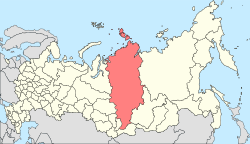Minusinsk
| Minusinsk (English) Минусинск (Russian) |
|
|---|---|
| - Town - | |
 Museum of Local Lore in Minusinsk |
|
 Location of Krasnoyarsk Krai in Russia |
|
|
|
|
|
|
|
|
|
|
| Administrative status (as of January 2014) | |
| Country | Russia |
| Federal subject | Krasnoyarsk Krai |
| Administratively subordinated to | krai town of Minusinsk |
| Administrative center of | krai town of Minusinsk,Minusinsky District |
| Municipal status (as of February 2009) | |
| Urban okrug | Minusinsk Urban Okrug |
| Administrative center of | Minusinsk Urban Okrug, Minusinsky Municipal District |
| Statistics | |
| Population (2010 Census) | 71,170 inhabitants |
| - Rank in 2010 | 220th |
| Time zone | KRAT (UTC+07:00) |
| Founded | 1739 |
| Town status since | 1822 |
| Dialing code(s) | +7 39132 |
|
|
|
| on | |
Minusinsk (Russian: Минуси́нск) is a historical town in Krasnoyarsk Krai, Russia. Population: 71,170 (2010 Census);72,561 (2002 Census);72,942 (1989 Census); 44,500 (1973).
Minusinsk marks the center of the Minusinsk Hollow, one of the most important archaeological areas north of Pazyryk. It is associated with the Afanasevo, Tashtyk, and Tagar cultures—all of them named after settlements in the vicinity of Minusinsk.
"About 330-200 B.C. the iron age triumphed at Minusinsk, producing spiked axes, partly bronze and partly iron, and a group of large collective burial places." Greco-Roman funerary masks, like those found at Pazyryk, make up the "Minusinsk group: at Trifonova, Bateni, Beya, Kali, Znamenka, etc." "The Indo-European aristocracy with its Sarmatian connections was succeeded at Minusinsk by the Kirghiz after the third century A.D."
The Russian settlement of Minyusinskoye (Минюсинское) was founded in 1739-1740 at the confluence of the Minusa River with the Yenisei. The Turkic Min Usa means "my brook", or "thousand rivers". The name transformed to Minusinskoye (Минусинское) in 1810.
By 1822, Minusinsk had emerged as a regional center of farming and transit trade and was granted town status. During the 19th century, it was a node of cultural activities for a very large area. The Martyanov Natural History Museum was opened there in 1877. It is still very active and publishes a quite useful annual report of its scientific findings, meetings, etc.
...
Wikipedia



